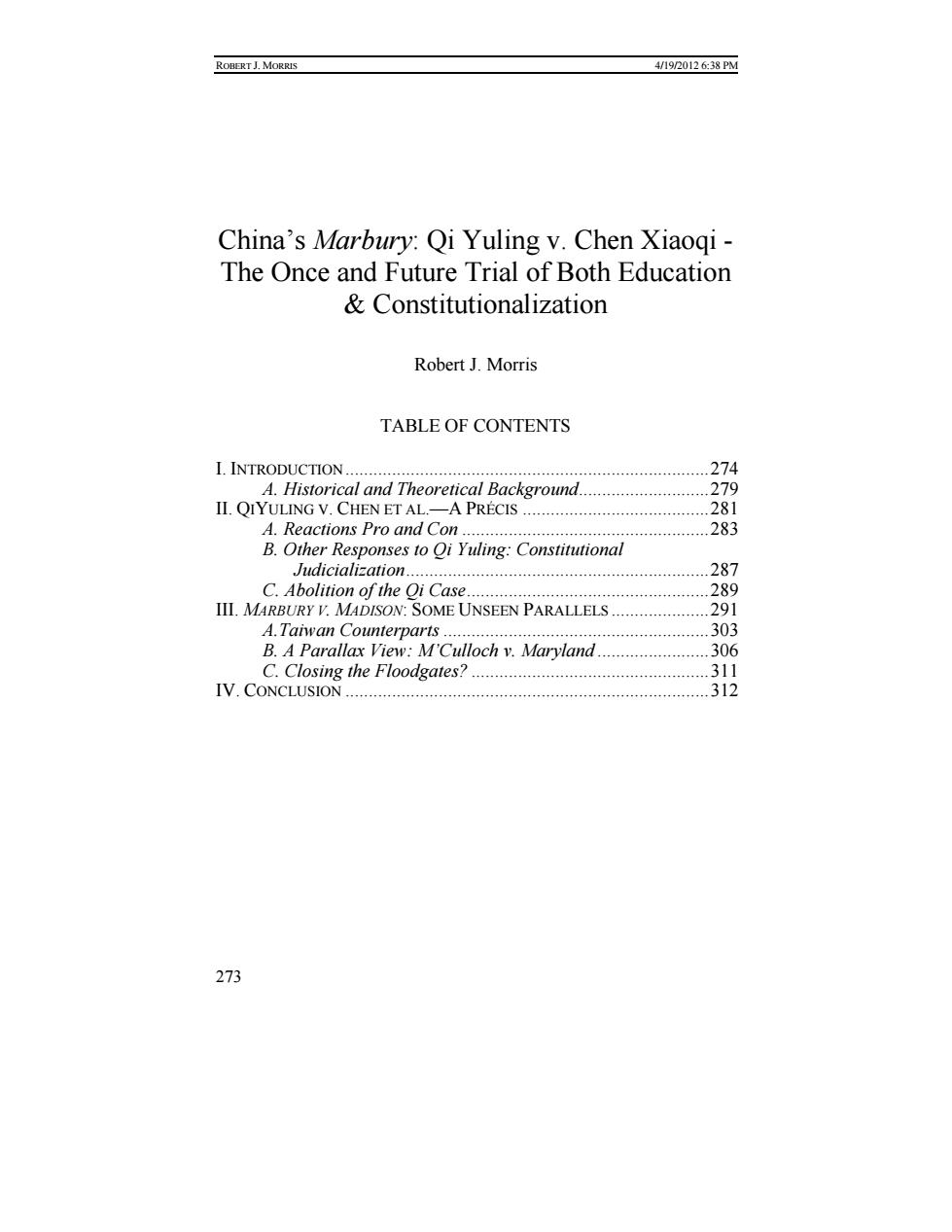
ROBERT J.MORRIS 4/19/20126:38PM China's Marbury:Qi Yuling v.Chen Xiaoqi- The Once and Future Trial of Both Education Constitutionalization Robert J.Morris TABLE OF CONTENTS I.INTRODUCTION........... 274 A.Historical and Theoretical Background........... 279 II.QIYULING V.CHEN ET AL-A PRECIS............ 281 A.Reactions Pro and Con.................. 283 B.Other Responses to Oi Yuling:Constitutional Judicialization.… 287 C.Abolition of the Oi Case... 289 III.MARBURY V.MADISON:SOME UNSEEN PARALLELS................... 291 A.Taiwan Counterparts............ 303 B.A Parallax View:M'Culloch v.Maryland................ 306 C.Closing the Floodgates? 311 IV.CONCLUSION… 312 273
ROBERT J. MORRIS 4/19/2012 6:38 PM 273 China’s Marbury: Qi Yuling v. Chen Xiaoqi - The Once and Future Trial of Both Education & Constitutionalization Robert J. Morris TABLE OF CONTENTS I. INTRODUCTION..............................................................................274 A. Historical and Theoretical Background............................279 II. QIYULING V. CHEN ET AL.—A PRÉCIS ........................................281 A. Reactions Pro and Con .....................................................283 B. Other Responses to Qi Yuling: Constitutional Judicialization.................................................................287 C. Abolition of the Qi Case....................................................289 III. MARBURY V. MADISON: SOME UNSEEN PARALLELS .....................291 A.Taiwan Counterparts .........................................................303 B. A Parallax View: M’Culloch v. Maryland ........................306 C. Closing the Floodgates? ...................................................311 IV. CONCLUSION ..............................................................................312
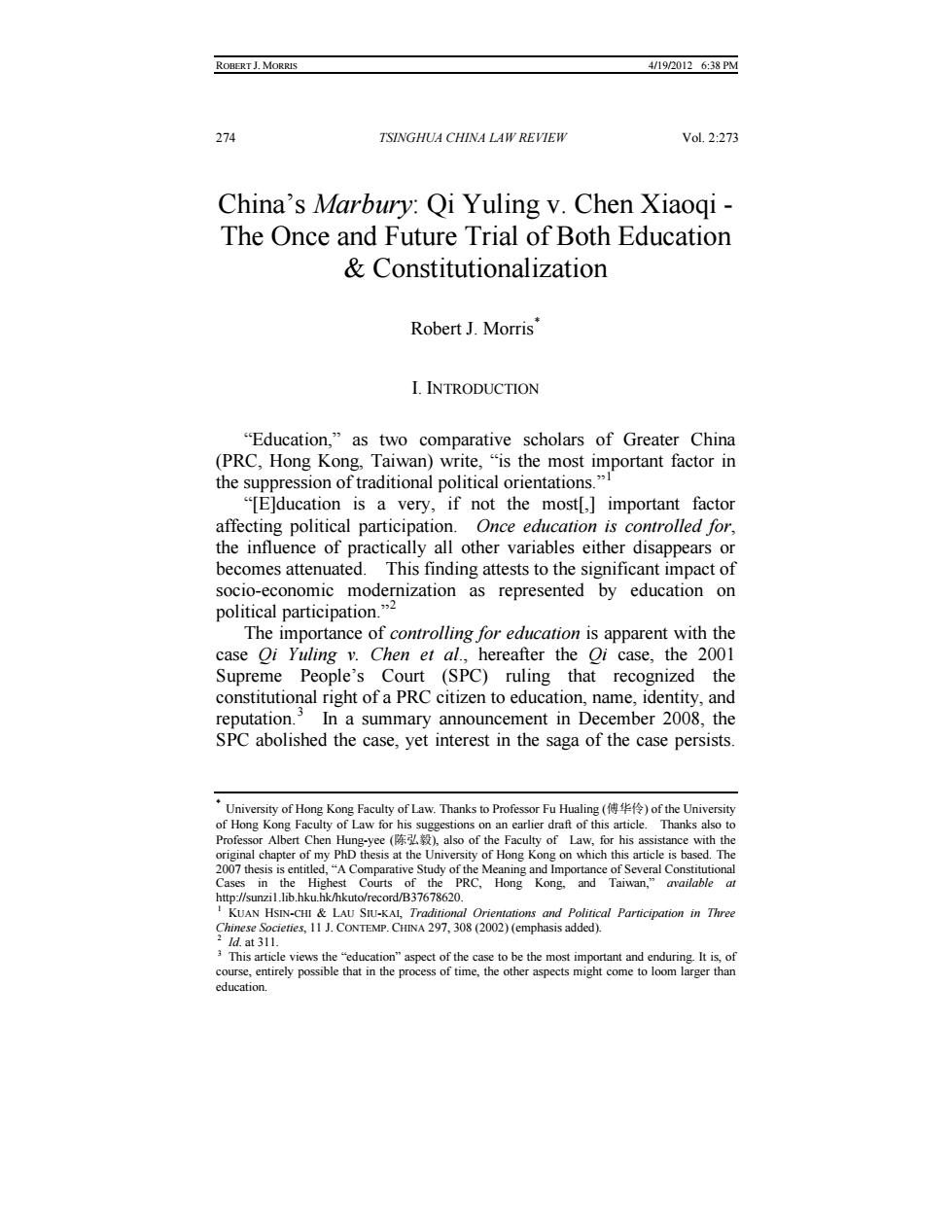
ROBERT J.MORRIS 4/19/20126:38PM 274 TSINGHUA CHINA LAW REVIEW Vol.2:273 China's Marbury:Qi Yuling v.Chen Xiaoqi- The Once and Future Trial of Both Education Constitutionalization Robert J.Morris I.INTRODUCTION "Education,"as two comparative scholars of Greater China (PRC,Hong Kong,Taiwan)write,"is the most important factor in the suppression of traditional political orientations." "[E]ducation is a very,if not the most[,]important factor affecting political participation.Once education is controlled for, the influence of practically all other variables either disappears or becomes attenuated.This finding attests to the significant impact of socio-economic modernization as represented by education on political participation."2 The importance of controlling for education is apparent with the case Oi Yuling v.Chen et al.,hereafter the Oi case,the 2001 Supreme People's Court (SPC)ruling that recognized the constitutional right of a PRC citizen to education,name,identity,and reputation.'In a summary announcement in December 2008,the SPC abolished the case,yet interest in the saga of the case persists. ‘University of Hong Kong Faculty of Law..Thanks to Professor Fu Hualing(傅华伶)ofthe University of Hong Kong Faculty of Law for his suggestions on an earlier draft of this article.Thanks also to Professor Albert Chen Hung-yee(陈弘s毅),also of the Faculty of Law,.for his assistance with the original chapter of my PhD thesis at the University of Hong Kong on which this article is based.The 2007 thesis is entitled,"A Comparative Study of the Meaning and Importance of Several Constitutional Cases in the Highest Courts of the PRC,Hong Kong,and Taiwan,"available at http://sunzil.lib.hku.hk/hkuto/record/B37678620. KUAN HSIN-CHI LAU STU-KAI,Traditional Orientations and Political Participation in Three Chinese Societies,11 J.CoNTEMP.CHINA 297,308(2002)(emphasis added). Id.at 311. 3 This article views the"education"aspect of the case to be the most important and enduring.It is,of course,entirely possible that in the process of time,the other aspects might come to loom larger than education
ROBERT J. MORRIS 4/19/2012 6:38 PM 274 TSINGHUA CHINA LAW REVIEW Vol. 2:273 China’s Marbury: Qi Yuling v. Chen Xiaoqi - The Once and Future Trial of Both Education & Constitutionalization Robert J. Morris* I. INTRODUCTION “Education,” as two comparative scholars of Greater China (PRC, Hong Kong, Taiwan) write, “is the most important factor in the suppression of traditional political orientations.”1 “[E]ducation is a very, if not the most[,] important factor affecting political participation. Once education is controlled for, the influence of practically all other variables either disappears or becomes attenuated. This finding attests to the significant impact of socio-economic modernization as represented by education on political participation.”2 The importance of controlling for education is apparent with the case Qi Yuling v. Chen et al., hereafter the Qi case, the 2001 Supreme People’s Court (SPC) ruling that recognized the constitutional right of a PRC citizen to education, name, identity, and reputation.3 * University of Hong Kong Faculty of Law. Thanks to Professor Fu Hualing (傅华伶) of the University of Hong Kong Faculty of Law for his suggestions on an earlier draft of this article. Thanks also to Professor Albert Chen Hung-yee (陈弘毅), also of the Faculty of Law, for his assistance with the original chapter of my PhD thesis at the University of Hong Kong on which this article is based. The 2007 thesis is entitled, “A Comparative Study of the Meaning and Importance of Several Constitutional Cases in the Highest Courts of the PRC, Hong Kong, and Taiwan,” available at http://sunzi1.lib.hku.hk/hkuto/record/B37678620. In a summary announcement in December 2008, the SPC abolished the case, yet interest in the saga of the case persists. 1 KUAN HSIN-CHI & LAU SIU-KAI, Traditional Orientations and Political Participation in Three Chinese Societies, 11 J. CONTEMP. CHINA 297, 308 (2002) (emphasis added). 2 Id. at 311. 3 This article views the “education” aspect of the case to be the most important and enduring. It is, of course, entirely possible that in the process of time, the other aspects might come to loom larger than education
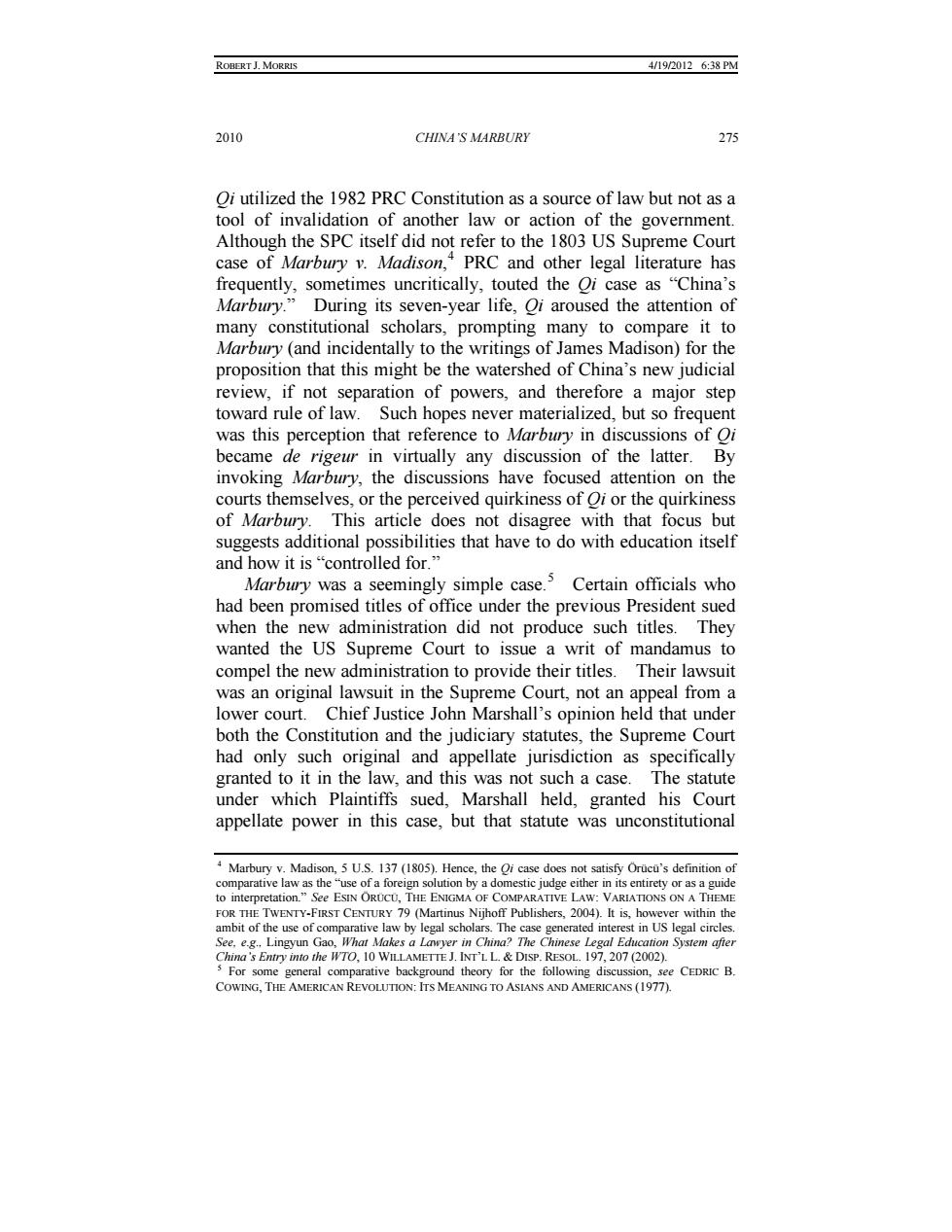
ROBERT J.MORRIS 4/19/20126:38PM 2010 CHINA'S MARBURY 275 Oi utilized the 1982 PRC Constitution as a source of law but not as a tool of invalidation of another law or action of the government. Although the SPC itself did not refer to the 1803 US Supreme Court case of Marbury v.Madison,PRC and other legal literature has frequently,sometimes uncritically,touted the Oi case as "China's Marbury."During its seven-year life,Oi aroused the attention of many constitutional scholars,prompting many to compare it to Marbury (and incidentally to the writings of James Madison)for the proposition that this might be the watershed of China's new judicial review,if not separation of powers,and therefore a major step toward rule of law.Such hopes never materialized,but so frequent was this perception that reference to Marbury in discussions of Oi became de rigeur in virtually any discussion of the latter.By invoking Marbury,the discussions have focused attention on the courts themselves,or the perceived quirkiness of Oi or the quirkiness of Marbury.This article does not disagree with that focus but suggests additional possibilities that have to do with education itself and how it is“controlled for..” Marbury was a seemingly simple case.5 Certain officials who had been promised titles of office under the previous President sued when the new administration did not produce such titles.They wanted the US Supreme Court to issue a writ of mandamus to compel the new administration to provide their titles.Their lawsuit was an original lawsuit in the Supreme Court,not an appeal from a lower court.Chief Justice John Marshall's opinion held that under both the Constitution and the judiciary statutes,the Supreme Court had only such original and appellate jurisdiction as specifically granted to it in the law,and this was not such a case.The statute under which Plaintiffs sued,Marshall held,granted his Court appellate power in this case,but that statute was unconstitutional 4 Marbury v.Madison,5 U.S.137(1805).Hence,the Qi case does not satisfy Orucu's definition of comparative law as the "use of a foreign solution by a domestic judge either in its entirety or as a guide to interpretation."See ESIN ORUCU,THE ENIGMA OF COMPARATIVE LAW:VARIATIONS ON A THEME FOR THE TWENTY-FIRST CENTURY 79 (Martinus Nijhoff Publishers,2004).It is,however within the ambit of the use of comparative law by legal scholars.The case generated interest in US legal circles. See,e.g..Lingyun Gao,What Makes a Lawyer in China?The Chinese Legal Education System after China's Entry into the WTO,10 WILLAMETTE J.INT'LL.DIsp.RESOL.197,207(2002). For some general comparative background theory for the following discussion,see CEDRIC B. COWING,THE AMERICAN REVOLUTION:ITS MEANING TO ASIANS AND AMERICANS (1977)
ROBERT J. MORRIS 4/19/2012 6:38 PM 2010 CHINA’S MARBURY 275 Qi utilized the 1982 PRC Constitution as a source of law but not as a tool of invalidation of another law or action of the government. Although the SPC itself did not refer to the 1803 US Supreme Court case of Marbury v. Madison, 4 Marbury was a seemingly simple case. PRC and other legal literature has frequently, sometimes uncritically, touted the Qi case as “China’s Marbury.” During its seven-year life, Qi aroused the attention of many constitutional scholars, prompting many to compare it to Marbury (and incidentally to the writings of James Madison) for the proposition that this might be the watershed of China’s new judicial review, if not separation of powers, and therefore a major step toward rule of law. Such hopes never materialized, but so frequent was this perception that reference to Marbury in discussions of Qi became de rigeur in virtually any discussion of the latter. By invoking Marbury, the discussions have focused attention on the courts themselves, or the perceived quirkiness of Qi or the quirkiness of Marbury. This article does not disagree with that focus but suggests additional possibilities that have to do with education itself and how it is “controlled for.” 5 4 Marbury v. Madison, 5 U.S. 137 (1805). Hence, the Qi case does not satisfy Örücü’s definition of comparative law as the “use of a foreign solution by a domestic judge either in its entirety or as a guide to interpretation.” See ESIN ÖRÜCÜ, THE ENIGMA OF COMPARATIVE LAW: VARIATIONS ON A THEME FOR THE TWENTY-FIRST CENTURY 79 (Martinus Nijhoff Publishers, 2004). It is, however within the ambit of the use of comparative law by legal scholars. The case generated interest in US legal circles. See, e.g., Lingyun Gao, What Makes a Lawyer in China? The Chinese Legal Education System after China’s Entry into the WTO, 10 WILLAMETTE J. INT’L L. & DISP. RESOL. 197, 207 (2002). Certain officials who had been promised titles of office under the previous President sued when the new administration did not produce such titles. They wanted the US Supreme Court to issue a writ of mandamus to compel the new administration to provide their titles. Their lawsuit was an original lawsuit in the Supreme Court, not an appeal from a lower court. Chief Justice John Marshall’s opinion held that under both the Constitution and the judiciary statutes, the Supreme Court had only such original and appellate jurisdiction as specifically granted to it in the law, and this was not such a case. The statute under which Plaintiffs sued, Marshall held, granted his Court appellate power in this case, but that statute was unconstitutional 5 For some general comparative background theory for the following discussion, see CEDRIC B. COWING, THE AMERICAN REVOLUTION: ITS MEANING TO ASIANS AND AMERICANS (1977)
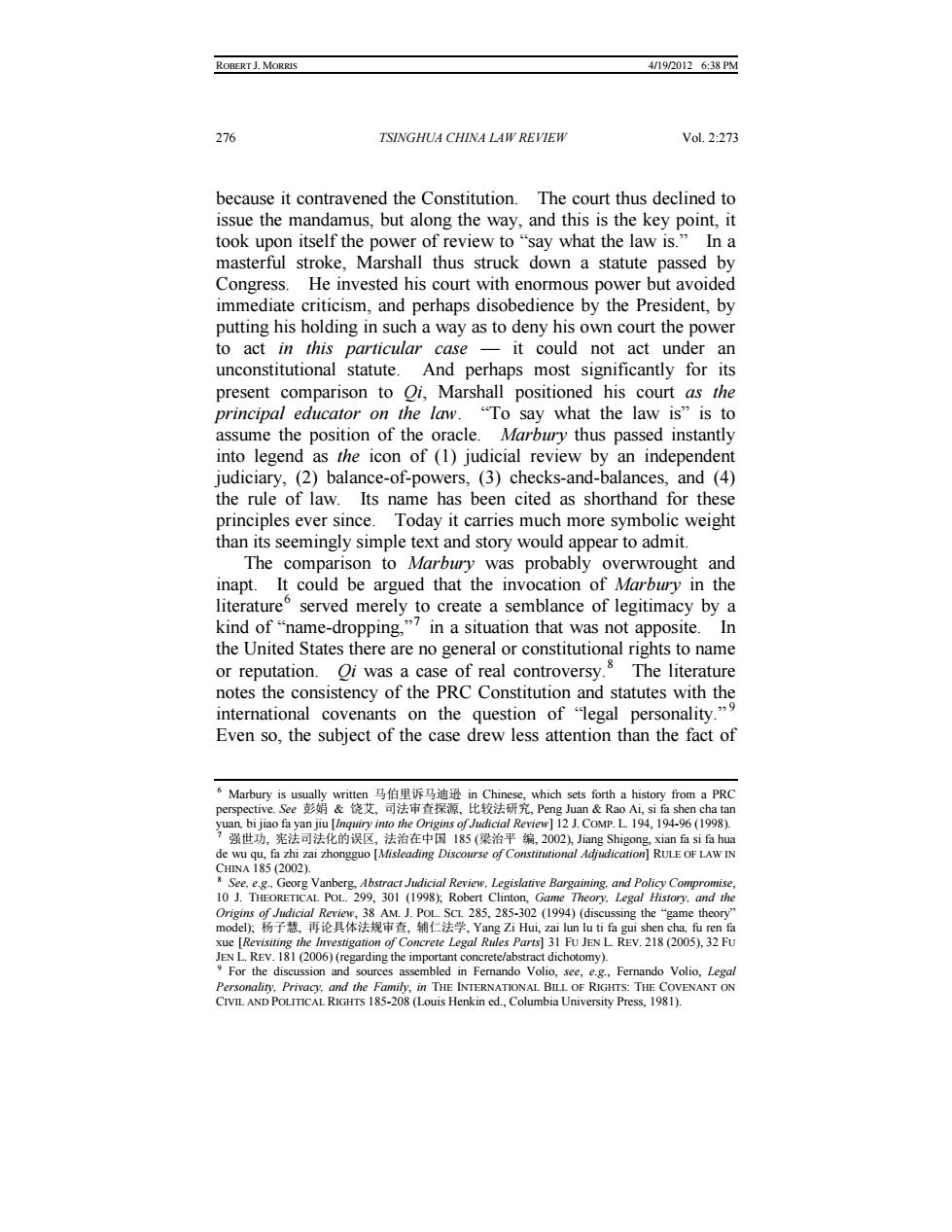
ROBERT J.MORRIS 4/19/20126:38PM 276 TSINGHUA CHINA LAW REVIEW Vol.2:273 because it contravened the Constitution.The court thus declined to issue the mandamus,but along the way,and this is the key point,it took upon itself the power of review to "say what the law is."In a masterful stroke,Marshall thus struck down a statute passed by Congress.He invested his court with enormous power but avoided immediate criticism,and perhaps disobedience by the President,by putting his holding in such a way as to deny his own court the power to act in this particular case-it could not act under an unconstitutional statute.And perhaps most significantly for its present comparison to Oi,Marshall positioned his court as the principal educator on the law."To say what the law is"is to assume the position of the oracle.Marbury thus passed instantly into legend as the icon of(1)judicial review by an independent judiciary,(2)balance-of-powers,(3)checks-and-balances,and (4) the rule of law.Its name has been cited as shorthand for these principles ever since.Today it carries much more symbolic weight than its seemingly simple text and story would appear to admit The comparison to Marbury was probably overwrought and inapt.It could be argued that the invocation of Marbury in the literature served merely to create a semblance of legitimacy by a kind of"name-dropping,"in a situation that was not apposite.In the United States there are no general or constitutional rights to name or reputation.Qi was a case of real controversy.8 The literature notes the consistency of the PRC Constitution and statutes with the international covenants on the question of "legal personality." Even so,the subject of the case drew less attention than the fact of 6 Marbury is usually written马伯里诉马迪逊in Chinese,which sets forth a history from a PRC perspective.See彭娟&饶艾,司法审查探源,比较法研究,Peng Juan&Rao Ai,.si fa shen cha tan yuan bi jiao fa yan jiu [Inquiry into the Origins of Judicial Review]1J.CoMp.L94194-96(1998). 7强世功,宪法司法化的误区,法治在中国185(梁治平编,2002),Jiang Shigong,xian fa si fa hua de wu qu,fa zhi zai zhongguo [Misleading Discourse of Constitutional Adjudication]RULE OF LAW IN CHINA185(2002). See.e.g..Georg Vanberg,Abstract Judicial Review.Legislative Bargaining.and Policy Compromise, 10 J.THEORETICAL POL.299,301 (1998),Robert Clinton,Game Theory.Legal History,and the Origins of Judicial Review,38 AM.J.POL.SCI.285,285-302 (1994)(discussing the "game theory" model),杨子慧,再论具体法规审查,辅仁法学,Yang Zi Hui,.zai lun lu ti fa gui shen cha,fu ren fa xue [Revisiting the Investigation of Concrete Legal Rules Parts]31 FU JEN L.REV.218 (2005),32 FU JEN L.REV.181 (2006)(regarding the important concrete/abstract dichotomy). For the discussion and sources assembled in Femando Volio,see,e.g Fernando Volio,Legal Personality,Privacy,and the Family,in THE INTERNATIONAL BILL OF RIGHTS:THE COVENANT ON CIVIL AND POLITICAL RIGHTS 185-208(Louis Henkin ed.,Columbia University Press,1981)
ROBERT J. MORRIS 4/19/2012 6:38 PM 276 TSINGHUA CHINA LAW REVIEW Vol. 2:273 because it contravened the Constitution. The court thus declined to issue the mandamus, but along the way, and this is the key point, it took upon itself the power of review to “say what the law is.” In a masterful stroke, Marshall thus struck down a statute passed by Congress. He invested his court with enormous power but avoided immediate criticism, and perhaps disobedience by the President, by putting his holding in such a way as to deny his own court the power to act in this particular case — it could not act under an unconstitutional statute. And perhaps most significantly for its present comparison to Qi, Marshall positioned his court as the principal educator on the law. “To say what the law is” is to assume the position of the oracle. Marbury thus passed instantly into legend as the icon of (1) judicial review by an independent judiciary, (2) balance-of-powers, (3) checks-and-balances, and (4) the rule of law. Its name has been cited as shorthand for these principles ever since. Today it carries much more symbolic weight than its seemingly simple text and story would appear to admit. The comparison to Marbury was probably overwrought and inapt. It could be argued that the invocation of Marbury in the literature6 served merely to create a semblance of legitimacy by a kind of “name-dropping,”7 in a situation that was not apposite. In the United States there are no general or constitutional rights to name or reputation. Qi was a case of real controversy. 8 The literature notes the consistency of the PRC Constitution and statutes with the international covenants on the question of “legal personality.” 9 6 Marbury is usually written 马伯里诉马迪逊 in Chinese, which sets forth a history from a PRC perspective. See 彭娟 & 饶艾, 司法审查探源, 比较法研究, Peng Juan & Rao Ai, si fa shen cha tan yuan, bi jiao fa yan jiu [Inquiry into the Origins of Judicial Review] 12 J. COMP. L. 194, 194-96 (1998). Even so, the subject of the case drew less attention than the fact of 7 强世功, 宪法司法化的误区, 法治在中国 185 (梁治平 编, 2002), Jiang Shigong, xian fa si fa hua de wu qu, fa zhi zai zhongguo [Misleading Discourse of Constitutional Adjudication] RULE OF LAW IN CHINA 185 (2002). 8 See, e.g., Georg Vanberg, Abstract Judicial Review, Legislative Bargaining, and Policy Compromise, 10 J. THEORETICAL POL. 299, 301 (1998); Robert Clinton, Game Theory, Legal History, and the Origins of Judicial Review, 38 AM. J. POL. SCI. 285, 285-302 (1994) (discussing the “game theory” model); 杨子慧, 再论具体法规审查, 辅仁法学, Yang Zi Hui, zai lun lu ti fa gui shen cha, fu ren fa xue [Revisiting the Investigation of Concrete Legal Rules Parts] 31 FU JEN L. REV. 218 (2005), 32 FU JEN L. REV. 181 (2006) (regarding the important concrete/abstract dichotomy). 9 For the discussion and sources assembled in Fernando Volio, see, e.g., Fernando Volio, Legal Personality, Privacy, and the Family, in THE INTERNATIONAL BILL OF RIGHTS: THE COVENANT ON CIVIL AND POLITICAL RIGHTS 185-208 (Louis Henkin ed., Columbia University Press, 1981)
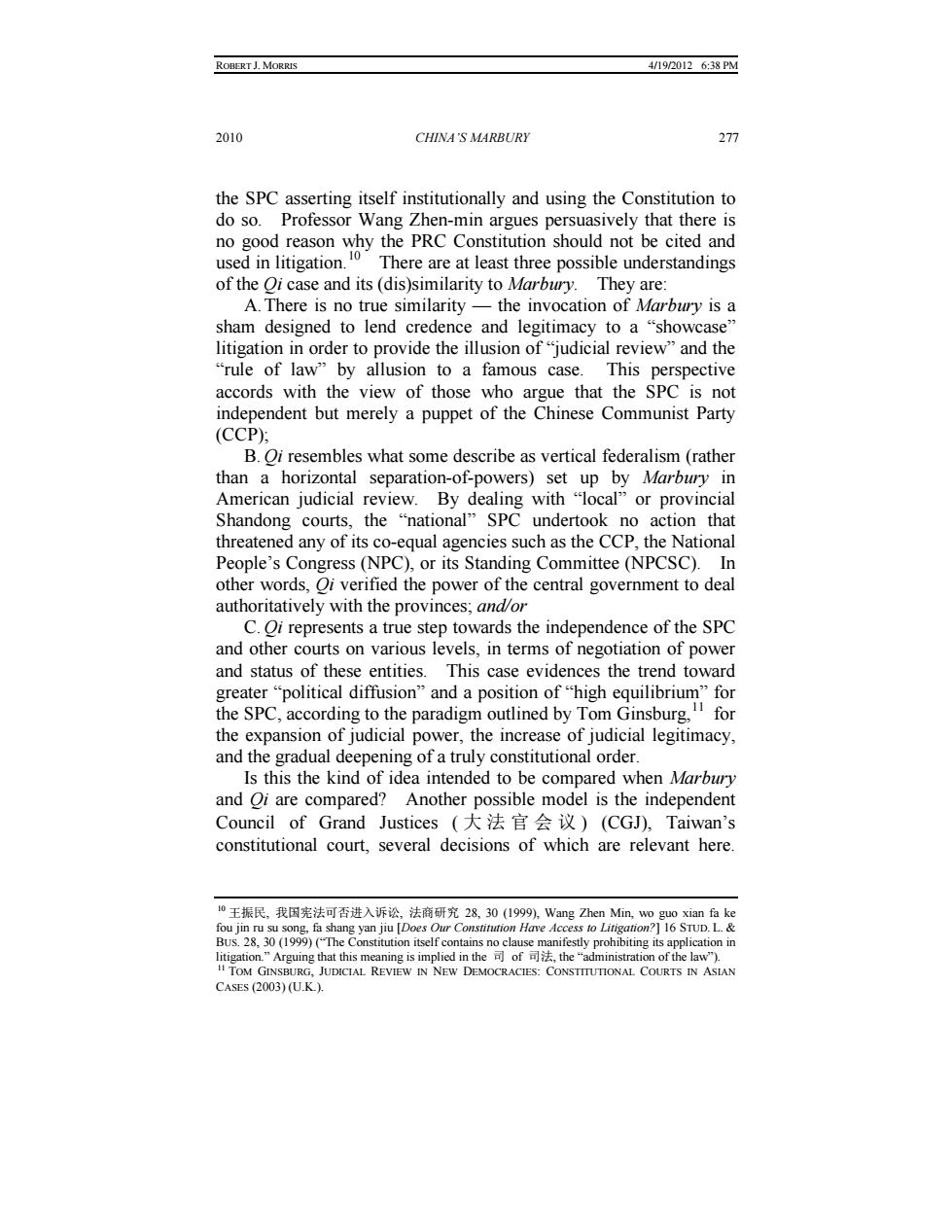
ROBERT J.MORRIS 4/19/20126:38PM 2010 CHINA'S MARBURY 277 the SPC asserting itself institutionally and using the Constitution to do so.Professor Wang Zhen-min argues persuasively that there is no good reason why the PRC Constitution should not be cited and used in litigation.There are at least three possible understandings of the Oi case and its(dis)similarity to Marbury.They are: A.There is no true similarity-the invocation of Marbury is a sham designed to lend credence and legitimacy to a "showcase" litigation in order to provide the illusion of"judicial review"and the "rule of law"by allusion to a famous case.This perspective accords with the view of those who argue that the SPC is not independent but merely a puppet of the Chinese Communist Party (CCP): B.Oi resembles what some describe as vertical federalism (rather than a horizontal separation-of-powers)set up by Marbury in American judicial review.By dealing with "local"or provincial Shandong courts,the "national"SPC undertook no action that threatened any of its co-equal agencies such as the CCP,the National People's Congress(NPC),or its Standing Committee (NPCSC).In other words,Oi verified the power of the central government to deal authoritatively with the provinces;andor C.Oi represents a true step towards the independence of the SPC and other courts on various levels,in terms of negotiation of power and status of these entities.This case evidences the trend toward greater "political diffusion"and a position of"high equilibrium"for the SPC,according to the paradigm outlined by Tom Ginsburg for the expansion of judicial power,the increase of judicial legitimacy, and the gradual deepening of a truly constitutional order. Is this the kind of idea intended to be compared when Marbury and Oi are compared?Another possible model is the independent Council of Grand Justices(大法官会议)(CGJ),Taiwan's constitutional court,several decisions of which are relevant here. 0王振民,我因宪法可否进入诉讼,法商研究28,30(1999),Wang Zhen Min,wo guo xian fa ke fou jin ru su song,fa shang yan jiu [Does Our Constitution Have Access to Litigation?]16 STUD.L.& BUs.28,30(1999)("The Constitution itself contains no clause manifestly prohibiting its application in litigation.”"Arguing that this meaning is implied in the司of司法,the“administration of the law"), TOM GINSBURG,JUDICIAL REVIEW IN NEW DEMOCRACIES:CONSTITUTIONAL COURTS IN ASIAN CASES (2003)(U.K.)
ROBERT J. MORRIS 4/19/2012 6:38 PM 2010 CHINA’S MARBURY 277 the SPC asserting itself institutionally and using the Constitution to do so. Professor Wang Zhen-min argues persuasively that there is no good reason why the PRC Constitution should not be cited and used in litigation.10 A.There is no true similarity — the invocation of Marbury is a sham designed to lend credence and legitimacy to a “showcase” litigation in order to provide the illusion of “judicial review” and the “rule of law” by allusion to a famous case. This perspective accords with the view of those who argue that the SPC is not independent but merely a puppet of the Chinese Communist Party (CCP); There are at least three possible understandings of the Qi case and its (dis)similarity to Marbury. They are: B. Qi resembles what some describe as vertical federalism (rather than a horizontal separation-of-powers) set up by Marbury in American judicial review. By dealing with “local” or provincial Shandong courts, the “national” SPC undertook no action that threatened any of its co-equal agencies such as the CCP, the National People’s Congress (NPC), or its Standing Committee (NPCSC). In other words, Qi verified the power of the central government to deal authoritatively with the provinces; and/or C. Qi represents a true step towards the independence of the SPC and other courts on various levels, in terms of negotiation of power and status of these entities. This case evidences the trend toward greater “political diffusion” and a position of “high equilibrium” for the SPC, according to the paradigm outlined by Tom Ginsburg, 11 Is this the kind of idea intended to be compared when Marbury and Qi are compared? Another possible model is the independent Council of Grand Justices ( 大法官会议 ) (CGJ), Taiwan’s constitutional court, several decisions of which are relevant here. for the expansion of judicial power, the increase of judicial legitimacy, and the gradual deepening of a truly constitutional order. 10 王振民, 我国宪法可否进入诉讼, 法商研究 28, 30 (1999), Wang Zhen Min, wo guo xian fa ke fou jin ru su song, fa shang yan jiu [Does Our Constitution Have Access to Litigation?] 16 STUD. L. & BUS. 28, 30 (1999) (“The Constitution itself contains no clause manifestly prohibiting its application in litigation.” Arguing that this meaning is implied in the 司 of 司法, the “administration of the law”). 11 TOM GINSBURG, JUDICIAL REVIEW IN NEW DEMOCRACIES: CONSTITUTIONAL COURTS IN ASIAN CASES (2003) (U.K.)